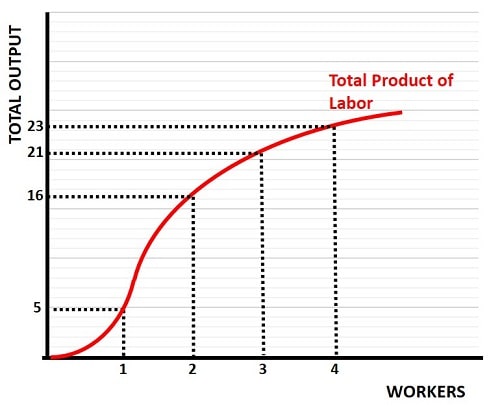- Home
- Economies of Scale
- Law of Diminishing Returns

The Law of Diminishing Returns Explained (with Graph & Examples)
The law of diminishing returns in economics, or diminishing marginal returns, is a simple concept that explains how an increasing amount of one of the inputs in the production process will eventually lead to lower and lower increases in output levels.
It is, of course, expected that there will initially be increasing returns rather than diminishing returns as an input such as labor is first introduced. This is because 2 workers may be able to work together more efficiently than a single worker, and 3 may be even better than two. However, beyond some point, each additional worker will only be able to increase overall output by less than the previous worker. Ultimately, if more and more workers are constantly added, they may start to get in each other's way and end up actually lowering overall output.
This is the law of diminishing returns, and it is applicable to all of the four factors of production, although it is generally more relevant to labor and capital as explained below.
Diminishing Marginal Returns Graph
The term diminishing marginal returns is sometimes used to describe the same concept, but it is actually more precise because it makes clear that we are concerned with the extra returns at the margin, i.e. the additional output created from the last additional worker, rather than the average returns from all workers employed.

In the graph above we can see the law of diminishing returns illustrated for all additional workers beyond the first 2. With only 1 worker, total output is equal to 5 units, with 2 workers this increases to 16 units, or a marginal increase of 11. With 3 workers and 21 units of total output the marginal increase has fallen to only 5 units. When 4 workers are employed, 23 units are produced in total, and only an additional 2 units are produced by adding that fourth worker.
Law of Diminishing Returns vs Returns to Scale
The law of diminishing returns states that increases of one factor of production, typically labor or capital, will after some point yield smaller and smaller increases in production. Note that we are talking about a single factor here, this is the key point because it denies that all factors can be increased simultaneously.
When we restrict the model to increases in a single factor it's an indicator that there is a time constraint which is relevant to our analysis i.e. we are dealing with the short-run. In most circumstances a firm will only be able to adjust its workforce in the short-run, and so labor is usually the factor under consideration here, but there may be circumstances where labor is difficult to adjust, e.g. when it is highly skilled and heavily unionized, but capital may be more flexible, e.g. when it is standard equipment and can easily be leased.
If we remove time as a constraint, then we would consider returns to scale and the long-run average cost curve when figuring out the most efficient combinations of factors for production of goods and services.
Law of Diminishing Returns Example
In the PDF link below, an example of the law of diminishing returns is given relating to agricultural economics. The explanation of diminishing marginal returns given above may seem intuitively obvious, and it is, but defining the precise amounts of inputs used in the production process and linking them to precise outputs is a difficult matter.
In terms of agricultural economics, as the paper explains, the 19th century German scientist Justus Von Liebig developed a theory known as the 'law of the minimum' regarding the proper use of combinations of plant nutrients in maximizing crop yields.
Whilst closely related to the law of diminishing returns, the law of the minimum was later shown to have been incorrectly stated, and it took four generations of soil chemists to come up with enough research to more accurately relate agricultural output to its factors of production in terms of the law of diminishing returns.
Sources:
Related Pages:
- Marginal Revenue Product
- Marginal Product of Labor
- Marginal Product of Capital
- Total Factor Productivity
- Factors of Production
- Costs of Production
- Economies of Scale
About the Author
Steve Bain is an economics writer and analyst with a BSc in Economics and experience in regional economic development for UK local government agencies. He explains economic theory and policy through clear, accessible writing informed by both academic training and real-world work.
Read Steve’s full bio
Recent Articles
-
U.S. Industrial Policy & The Unfortunate Sacrifice that Must be Made
Dec 12, 25 03:03 AM
U.S. Industrial Policy now demands a costly tradeoff, forcing America to rebuild its industry while sacrificing bond values, pensions, and the cost of living. -
The Global Currency Reset and the End of Monetary Illusion
Dec 07, 25 03:48 AM
The global currency reset is coming. Learn why debt, inflation, and history’s warnings point to a looming transformation of the world’s financial system. -
Energy Economics and the Slow Unraveling of the Modern West
Dec 06, 25 05:18 AM
Energy economics is reshaping global power as the West faces decline. Explore how energy, geopolitics, and resource realities drive the unfolding crisis. -
Our Awful Managed Economy; is Capitalism Dead in the U.S.?
Dec 05, 25 07:07 AM
An Austrian analysis of America’s managed economy, EB Tucker’s warning, and how decades of intervention have left fragile bubbles poised for a severe reckoning. -
The Looming Global Debt Crisis – According to Matthew Piepenburg
Dec 04, 25 02:38 PM
A deep analysis of the unfolding global debt crisis, rising systemic risks, and the coming reckoning for bonds, stocks, real estate, and the dollar.